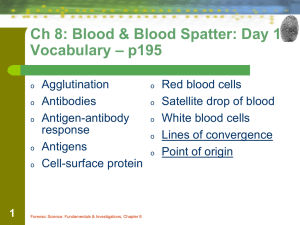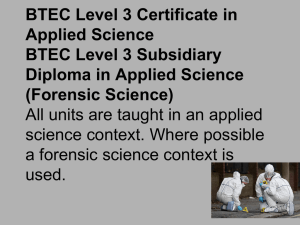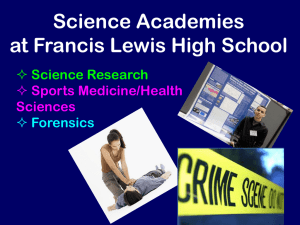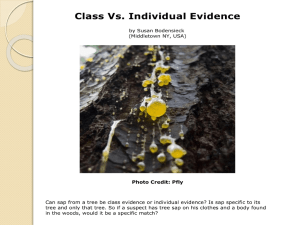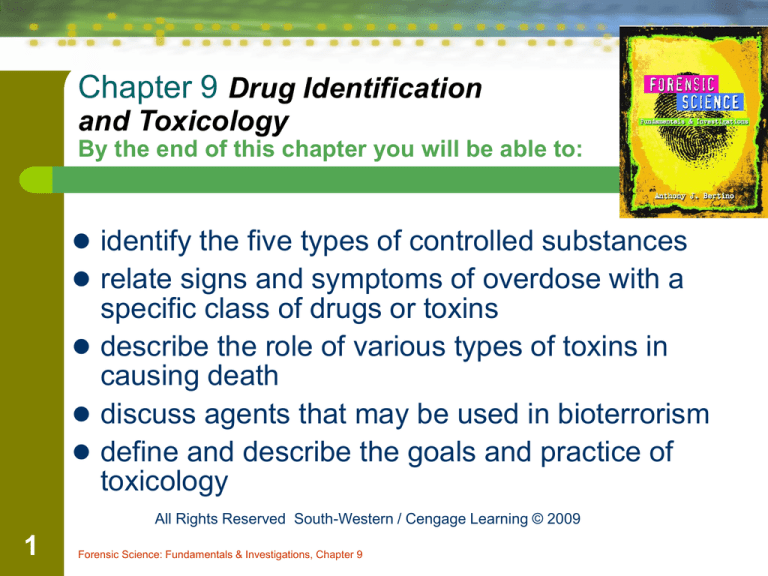
Chapter 9 Drug Identification
and Toxicology
By the end of this chapter you will be able to:
identify the five types of controlled substances
relate signs and symptoms of overdose with a
specific class of drugs or toxins
describe the role of various types of toxins in
causing death
discuss agents that may be used in bioterrorism
define and describe the goals and practice of
toxicology
All Rights Reserved South-Western / Cengage Learning © 2009
1
Forensic Science: Fundamentals & Investigations, Chapter 9
Introduction
Forensic toxicology helps determine (a) the cause-andeffect relationships between exposure to a drug or other
substance and (b) the toxic or lethal effects from that
exposure.
People can be exposed to toxic substances:
intentionally—by treating illness or relieving pain
accidentally—by harmful combinations or overdoses
deliberately—by harming or killing others or by
committing suicide
2
Forensic Science: Fundamentals & Investigations, Chapter 9
Poison—Murder, Accidental
Overdoses,
and Drug Offences
Less than ½ of 1% of all homicides results
from poisoning.
Accidental drug overdoses are more
common.
More than 50% of the federal prison
population and about 20% of the population
in state prisons consist of drug offenders.
3
Forensic Science: Fundamentals & Investigations, Chapter 9
Controlled Substances—Hallucinogens
The effect and intensity of response to these
drugs varies from person to person.
Often derived from plants, hallucinogens
affect the user’s perceptions, thinking, selfawareness, and emotions.
Affects of an overdose include an increased
heart rate, often increased blood pressure,
and sometimes panic attacks, anxiety, or
psychosis.
4
Forensic Science: Fundamentals & Investigations, Chapter 9
Controlled Substances—Narcotics
Narcotics reduce pain and can be very habit forming.
5
Forensic Science: Fundamentals & Investigations, Chapter 9
Controlled Substances—Stimulants
Stimulants increase feelings of energy
and alertness while suppressing appetite.
As the drug wears off, however,
depression often results.
Affects of an overdose can include high
blood pressure, agitation, confusion, or
seizures.
Stimulants tend to be highly addictive.
6
Forensic Science: Fundamentals & Investigations, Chapter 9
Controlled Substances—Anabolic
Steroids
These drugs are produced in a laboratory and
have a chemical structure similar to
testosterone.
Anabolic steroids promote cell and tissue
growth increasing bone mass and body
muscle.
Because of this they are popular with
weightlifters, bodybuilders, and other athletes.
What are some of the negative side effects that
are possible?
7
Forensic Science: Fundamentals & Investigations, Chapter 9
Controlled Substances—Depressants
Depressants act on the central nervous system
and increase the activity of a neurotransmitter
called GABA.
Increased GABA production results in
drowsiness and slowed brain activity.
These drugs, consequently, relieve anxiety and
produce sleep.
Mixing depressants with alcohol and other
drugs increases their effects and health risks,
possibly leading to coma and death.
8
Forensic Science: Fundamentals & Investigations, Chapter 9
Controlled Substances—Alcohols
In what way are alcohols toxic?
How is grain alcohol produced?
What are the classic symptoms of a
hangover?
What is the effect of alcohol on the central
nervous system?
What can chronic abuse of alcohol cause?
9
Forensic Science: Fundamentals & Investigations, Chapter 9
Controlled Substances—Bacterial
Toxins
Tetanus
Lockjaw, as it is sometimes called, is produced by
the Clostridium tetani bacteria.
Its poison can cause violent muscle spasms.
Botulism
Produced by the bacteria Clostridium botulinum,
botulism paralyzes muscles.
It causes irreversible damage to nerve endings.
Very small amounts are extremely deadly.
Botulism is the most poisonous biological substance.
10
Forensic Science: Fundamentals & Investigations, Chapter 9
Controlled Substances—Pesticides and
Heavy Metals
Pesticides mostly are used to protect plants or food crops.
Metal compounds are very poisonous.
11
Forensic Science: Fundamentals & Investigations, Chapter 9
Controlled Substances—Pesticides and
Heavy Metals
Metal compounds can damage many organs in the body.
12
Forensic Science: Fundamentals & Investigations, Chapter 9
Controlled Substances—Bioterrorism
Agents
Ricin
is a poisonous protein in the castor bean.
is lethal in extremely small amounts.
can enter the body in various ways:
– inhaled as a mist or a powder.
– ingested as food or drink.
– injected into the body.
can cause death within a few hours.
13
Forensic Science: Fundamentals & Investigations, Chapter 9
Controlled Substances—Bioterrorism
Agents
Anthrax
is caused by the bacteria Bacillus anthracis, which
forms spores.
can be spread to humans from infected animals.
can enter the human body through:
– inhalation; causing breathing problems that usually
result in death.
– ingestion; becoming fatal in 25% to 60% of cases.
– absorption via the skin; leading to death in about
20% of untreated cases.
14
Forensic Science: Fundamentals & Investigations, Chapter 9
. . . . . . . . . . . . . . . . . Summary
Forensic toxicology seeks to identify poisons or
15
drugs in criminals and victims.
Toxicology is important in studying cases of drug
overdose and sporting violations.
Controlled substances fall into five main groups.
Poisons can be produced by living organisms.
Pesticides and heavy metals are common poisons.
Bioterrorism agents include ricin and anthrax.
Forensic Science: Fundamentals & Investigations, Chapter 9





